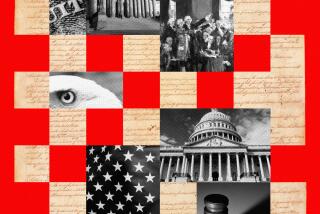We the People: THE AMERICAN CONSTITUTION AFTER 200 YEARS : The Politics of Change : Making amendments: Many tried, few succeeded.
- Share via
It is one measure of the success of the Constitution’s drafters that, after the adoption in 1791 of the 10 amendments that constitute the Bill of Rights, the original document has been changed only 16 times.
Only six of those amendments deal with the structure of the government established by the 55 men who labored in Philadelphia through the summer of 1787. Clearly, Americans have been generally pleased with their governmental apparatus.
With two obvious exceptions--Prohibition and its revocation--the main thrust of the other 10 amendments has been to protect or expand rights and liberties already guaranteed or implied in the Declaration of Independence, the Constitution and the Bill of Rights.
Not for a want of proposals has the Constitution survived with so few changes. During the 200 years since the drafting of the original document, Congress has considered no fewer than 10,000 ideas for amending it.
Some seem frivolous. In 1808, for example, a Connecticut senator suggested that the nation choose its President through an annual random drawing from a list of retiring senators. (He happened to be about to retire.) An 1893 proposal would have named the country “the United States of the World.”
Others addressed serious national concerns. The debate over the equal rights amendment was kicked off as far back as 1923 with a proposal to guarantee equal rights for men and women.
If few of these proposals have been grafted to the Constitution, it is in no small part because the Constitution’s authors intentionally made it extraordinarily difficult to tamper with their handiwork.
Amendments must follow one of two routes. Under the one that was followed by all 26 amendments to date, two-thirds majorities of each house of Congress voted their approval, and three-fourths of the state legislatures added their ratification.
The second route is so arduous that it has never even been tried. Legislatures of two-thirds of the states may vote to call a constitutional convention, whose proposed amendments must then be ratified by three-fourths of the state legislatures. At present, 32 state legislatures--two short of the required 34--have voted to call a convention to draft an amendment requiring a balanced budget, but the movement seems to have run out of steam.
The Constitution of 1787, by failing to guarantee Americans the rights of life, liberty and the pursuit of happiness, represented a retreat from the Declaration of Independence. The Bill of Rights was designed to help correct that oversight.
Of the 16 amendments adopted since the Bill of Rights, six corrected what were perceived as flaws in the political structure erected by the Constitution:
- In 1793 the Supreme Court angered states by accepting jurisdiction in a case where an individual sued the state of Georgia. To ensure that that did not occur again, Congress and the states added the 11th Amendment in 1798.
- The 12th Amendment (1804), which could be called the Aaron Burr amendment, mandated that presidential and vice presidential candidates run as a ticket. Until then, the presidential candidate with the most Electoral College votes became President and the runner-up, vice president. But that created political turmoil in 1800 when Burr, as the vice presidential candidate on a ticket headed by Thomas Jefferson, received the same number of electoral votes as Jefferson and appeared interested in gaining the presidency himself. The House of Representatives ultimately decided the election in Jefferson’s favor.
- The 16th Amendment (1913) authorized the income tax, which a narrowly divided Supreme Court had determined in 1895 to be unconstitutional.
- By quirks of the date of elections when the U.S. government first began operations, long periods elapsed between the election of national officials and their assumption of office. That problem was corrected in 1933 with the 20th Amendment, which set Jan. 20 as the date when the winner of the previous November’s presidential election takes the oath of office.
- The 22nd Amendment, adopted in 1951, seven years after Franklin D. Roosevelt was elected to his fourth term, limited presidents to two terms. The Founding Fathers, convinced that the President would be more diligent if the possibility of reelection always loomed, had rejected the idea of making the President ineligible for reelection after a seven-year term.
- The Constitution did not allow for selecting a new vice president when the old one succeeds the President. In the wake of the assassination of President John F. Kennedy, the 25th Amendment (1967) created a system that allowed the President and Congress to select a vice president. The amendment also established a system to deal with the possibility that a President might become incapacitated.
The 18th and 21st Amendments are a special tandem. In 1919, amid the fervor of “reform” that had swept over the nation in the early 20th Century, the states approved a prohibition on “intoxicating liquors.”
But the Roaring ‘20s, complete with speak-easies, bathtub gin and bootlegging, soon demonstrated that Prohibition was not working. In 1933, Congress proposed an amendment to repeal Prohibition, and the 21st Amendment was adopted in the near-record time of 286 days. The fate of the 18th Amendment demonstrated the difficulty of “legislating morality.”
The other eight amendments adopted since the Bill of Rights helped graft the ideals of the Declaration of Independence to the Constitution. Slavery generated four of them:
- Because the Founding Fathers sanctioned slavery, only a constitutional amendment could abolish it. The 13th Amendment did just that in 1865, two years after President Abraham Lincoln’s Emancipation Proclamation.
- When Southern states tried in essence to reimpose slavery through laws and violence, the 14th Amendment was adopted in 1868 to protect the civil rights of the former slaves. In a clear echo of the Declaration of Independence, this amendment says all citizens have the right to legal protection of their “Life, Liberty and Property.”
- Two years later, the 15th Amendment was added in an effort to ensure the former slaves’ right, and the right of others, to vote.
- Problems persisted, and in 1964 the 24th Amendment abolished poll taxes, which some states had used to deny the vote to minorities, especially blacks.
Four other amendments were aimed at expanding or guaranteeing the right to vote:
- In 1913, the 17th Amendment required direct election of senators.
- Seven years later, the 19th Amendment opened all voting booths to women, potentially doubling the number of voters.
- The residents of the District of Columbia were, by the 23rd Amendment enacted in 1961, allowed to vote in presidential elections.
- In 1971, the most recently adopted amendment, the 26th, extended the vote to 18-year-olds.
It is one of the beauties of the Constitution that it can be altered to meet changing circumstances and evolving views of the government’s role. Over the years, the amending process has moved the 1787 Constitution closer to the noble ideals of the Declaration of Independence.
More to Read
Get the L.A. Times Politics newsletter
Deeply reported insights into legislation, politics and policy from Sacramento, Washington and beyond. In your inbox twice per week.
You may occasionally receive promotional content from the Los Angeles Times.









